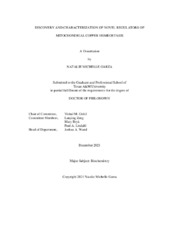| dc.description.abstract | Copper is an essential micronutrient that is used as a cofactor for enzymes involved in diverse cellular processes including mitochondrial respiration and iron transport. However, free copper is highly reactive and deleterious for cellular health. Therefore, conserved chaperones and transporters have evolved to carry out intracellular copper transport. Mutations in these proteins result in fatal human pathologies. Despite the importance of copper in cellular health and human disease, we currently do not know the factor(s) required for copper transport to mitochondria. Here, I utilized yeast genetics, biochemistry, and pharmacology to characterize genes and small molecules that impact copper transport to mitochondria.
First, to identify novel genetic regulators of copper trafficking to mitochondria, I performed a genome-wide copper-sensitized screen using Saccharomyces cerevisiae deletion mutants. This screen identified many genes required for vacuolar biogenesis as putative regulators of mitochondrial copper homeostasis. Biochemical characterization of these mutants revealed that vacuolar acidity is critical for maintaining the levels of mitochondrial copper. I further show that the activity of cytochrome c oxidase (CcO), a mitochondrial cuproenzyme, could be synthetically controlled by altering vacuolar pH or by supplementing media with additional copper. Through this comprehensive genomic study, I identified several novel genetic regulators of mitochondrial copper homeostasis and uncovered a biochemical mechanism that link vacuolar pH to mitochondrial energy metabolism.
Second, I focused my attention on characterizing elesclomol (ES), an investigational anticancer drug, which was recently shown to deliver copper to mitochondrial CcO. Utilizing mass spectrometry and yeast sub-cellular fractionation, I showed that ES treatment leads to a striking increase in cellular and mitochondrial iron levels along with the expected increase in copper levels. I used yeast mutants of iron and copper transport to determine that ES-mediated increase in cellular iron is dependent on Fet3, a component of iron import machinery. Fet3 is a copper-containing oxidase that receives copper in the Golgi compartment. Thus, my work suggests that ES can transport copper to the Golgi lumen as well. Collectively, my work has identified novel regulators of mitochondrial copper levels and provided new insights on the application of ES for the disorders of copper and iron metabolism. | |


